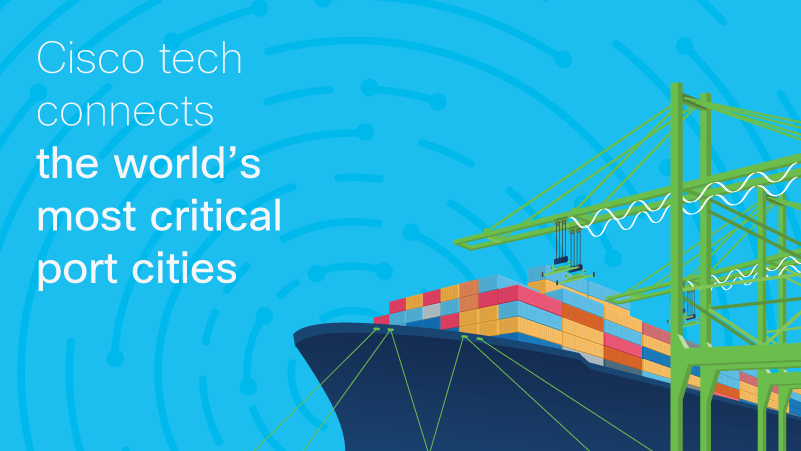On a typical day in a major port, cargo ships carrying up to 20,000 shipping containers slide into berth. Then massive cranes swing into action, as freight trains and trucks wait to haul off the toys, food, electronics, furniture, and cars that keep the global economy humming.
It’s a delicate dance of machines, goods, and people that demands the kind of precise choreography that only digital technologies can enable.
“It’s all about port efficiency,” said Kyle Connor, Cisco’s global transportation principal. “Because when ports aren’t running right, they become an absolute bottleneck to supply chains. Ships are sitting in the water waiting to come in, trains are idling on tracks, and trucks are backed up, wasting fuel and emitting carbon. So, automation and digitization are more important than ever.”
Today’s global supply chain challenges underscore the point. As ships back up at major ports and containers sit on docks, markets turn volatile and consumer frustrations mount. A complex combination of forces are at work — everything from resource shortages to a dearth of truck drivers — but it still highlights the imperative for making ports as efficient, productive, and sustainable as possible.
Cisco is doing just that, in port cities as far flung as Rotterdam, Lyon, Singapore, Malta, Charleston, Anchorage, and Los Angeles — with solutions that range from edge computing and Internet of Things (IoT) to security and wireless connectivity.
“Ports are under tremendous pressure to be more efficient,” said Patricia Costa, Cisco’s senior product manager for IoT, “in terms of how fast they can get a ship in, rotate its containers or other cargo, and send if off on a truck or train. And they are automating or digitizing a lot of vehicles, cranes, and other elements to speed the process.”
Tying all those assets together securely and seamlessly is essential.
“It demands a really great, consistent network with high speed and low latency,” Costa added, “because if they lose that connectivity, they can have an accident or at the very least lose a lot of money.”
Raising the bar in Rotterdam
As digital business director for Cisco, Netherlands, Niels van den Berg has played a lead role in transforming the Port of Rotterdam into one of the most advanced and innovative in the world. This 42-square mile port is Europe’s largest, and it’s essential to the region’s economy and beyond.
Like most ports, Rotterdam has its unique challenges, including widely divergent tidal levels and currents, and unpredictable northern European weather. So, knowing precisely what is happening when and where is essential.
“There are thousands of IoT sensors in the port,” van den Berg explained, “to monitor all of the mission-critical assets and processes, along with weather, tidal conditions that can prevent safe passage, and other environmental factors that influence a ship’s behavior.”
Connecting, processing, and securing the resulting terabytes of data is a job for Cisco solutions — such as Cisco Cyber Vision, Cisco Ultra-Reliable Wireless Backhaul, and an array of Cisco Meraki cameras and industrial switches and routers.
Another location benefitting from Cisco Internet of Things and wireless technologies is Malta Freeport, the third largest transshipment port in the Mediterranean.
“Cisco IoT gives Malta Freeport the wireless connectivity and scalability we need to stay competitive in the shipping industry,” said Jesmond Baldacchino, Malta Freeport Terminals’ Head of IT. “An IoT solution like Cisco Ultra-Reliable Wireless Backhaul is what helps shipping ports like ours continue to support and grow our operational technology environment.”
Taking ports to the edge
Edge computing is another critical element that is future-proofing port terminals.
“All of that combined data is provided in multiple clouds and processed in real time with our edge-intelligence platform,” van den Berg said. “That’s where it makes the most sense and provides the most value.”
That value is all about providing actionable insights for workers (and automated processes) around the port — precisely when they are needed and without backhauling to a data center.
“By working on the data in real time at the edge,” van den Berg continued, “we can validate it quickly by the criteria set by the harbor master. Digitizing your critical infrastructure in this way creates a proper view of your port, your roads, and your railways. From an operational excellence perspective, it really makes sense.”
In some large ports, Cisco has also helped to create digital twins of the entire ecosystem. That’s a virtual representation informed by real-time data of all the key assets — one that can predict outcomes and results.
“The technologically advanced ports like Rotterdam are adapting the digital twin,” said Connor. “It represents the fixed assets like the port itself and the cranes. But it also calculates around the buoyancy of different-sized ships, the water levels, the speed of the trains heading into the harbor, and so on. It’s about truly understanding asset utilization and getting more ships through that harbor safer and faster. And avoiding supply chain bottlenecks.”
Once those containers are hauled onto a dock, coordinating trucks and trains for pickup is essential. Costa’s team is working on improved solutions for tracking containers, trucks, and rail.
“Using optical character recognition,” she explained, “we can use cameras to automate the identification of containers by reading the labels and also the license plates on trucks. That way we can automatically manage the whole process."
Of course, port terminals are high priority targets for hackers, as illustrated by a 2019 attack on Maersk, the world’s largest shipping conglomerate. Ever since, cybersecurity has been treated with ever-increasing importance, all of which aligns with Cisco’s overarching approach to security.
“Security is built into everything that we do,” said Connor. “It’s ground zero, it’s at the baseline. It’s not bolted on after the fact.”
At the heart of any port — people
As our current supply chain issues reveal, worker shortages are a growing problem. Cisco is leading the way with hybrid work solutions that make work more flexible and inclusive. And its port terminal solutions can go a long way towards improving the lives of skilled, talented workers. Not to replace them, but to augment and empower them.
“The technology is enabling people to operate things remotely,” said Costa. “So, they could be in an air-conditioned place away from potential danger or accidents, instead of in the hot sun or up 300 feet in crane.”
Predictive maintenance is another IoT solution that improves safety and cuts downtime.
“To have more efficient, effective machines operating at their optimal capacity, you need to know what’s going on with those machines," said Don Leyn, Cisco’s specialist for ports, terminals, and mining for North America. “Simple details, like watching the tire pressure on heavy equipment, makes a difference. Are they running at the right engine temperatures? What are the oil levels?”
Predictive maintenance can also avert disaster, Leyn was quick to add.
“By monitoring the stress levels of the steel on a crane,” he explained, “you can tell if it’s getting ready to crack. With this type of automated monitoring, you can be proactive in the maintenance of the port machines. That reduces downtime and increases productivity of the terminal.”
Automation is another factor in improving port efficiencies, while addressing talent shortages.
“In 2016,” Leyn stated, “it was estimated that 42 percent of the world’s port/terminal workforce would retire in the next five to seven years. That set off alarms to the ports. Since then the pandemic has exacerbated the situation, driving more people away from this type of work. Automation can help to shore up some of these labor shortages.”
In addition to supporting the workforce, efficiency and sustainability help make port zones desirable places to live.
“We’re seeing a lot of port revitalization,” Connor said, “with new options for entertainment and mixed living spaces, which was rarely the case in the past. As a port is taking care of their digital footprint for their own improved operations and improving safety, keeping workers becomes easier. Because they’re also building a connected community, with high bandwidth, smart roadways, cleaner air and water.”
Revitalized port neighborhoods support the law of unintended benefits. From efficiency and competitiveness to worker well-being and sustainability, digital transformation improves people’s lives in a multitude of ways.
And while our global supply chain problems won’t be solved overnight, they represent a great opportunity: to spur innovations and investments that will drive lasting change.
“U.S. ports are among the most aged in the world,” said Leyn, “and the infrastructure bill is going to be a massive catalyst to get them modernized. But the rest of the world is experiencing challenges as well. I see Cisco being a major player globally in this space.”
###




